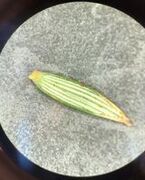Biology:Leptecophylla parvifolia
| Leptecophylla parvifolia | |
|---|---|
Error creating thumbnail: Unable to save thumbnail to destination
| |
| Photograph of the plant species Leptecophylla parvifolia on Kunanyi/Mt Wellington, Hobart, Tasmania. | |
| Scientific classification Error creating thumbnail: Unable to save thumbnail to destination
| |
| Kingdom: | Plantae |
| Clade: | Tracheophytes |
| Clade: | Angiosperms |
| Clade: | Eudicots |
| Clade: | Asterids |
| Order: | Ericales |
| Family: | Ericaceae |
| Genus: | Leptecophylla |
| Species: | L. parvifolia
|
| Binomial name | |
| Leptecophylla parvifolia (R.Br.) Jarman
| |
Leptecophylla parvifolia, commonly known as the mountain pinkberry, is a small to medium sized shrub within the Ericaceae family and is endemic to the highlands of Tasmania.[1] This species was first collected and documented in 1804 by Robert Brown and was formerly included in the Cythodes genus.[1] It was then as noted as subspecies of Leptecophylla junipernia but in 2018, was classified as its own species[1]
Habit
It grows as an erect, compact, and rounded shrub, typically wider than it is high.[1] This species typically ranges in height from 50-150cm, rarely exceeding 2m.[2] L. parvifolia is common in open eucalypt woodlands and within rainforest communities.[1] It occurs throughout the southern, central and northeast highlands of Tasmania at altitudes above 500 metres and can form the dominant shrub layer in some locations (e.g. the Central Plateau).[1] In the southeast, its primarily found on rocky dolerite slopes but also can occur on Carboniferous-Devonian rock types[3]
Description
The leaves of this species are small, hence the name ‘parvifolia’ which translates roughly to ‘small leaves’.[citation needed] The leaves are alternately arranged and smaller than other Leptecophylla species, often <7mm, dark green in colour and pungent.[1][4] They are linear-lanceolate while the margins are slightly recurved, the apex of the leaves comes to a sharp point. The abaxial surface is pale white and waxy which displays a distinct striate pattern. However, the venation is typically narrow palmate and gives the appearance of being parallel due to the curvature of the margins and small leaf size.[5]
This species bares small, white, bell shaped flowers that are smaller than then that of the other species in this genus.[1] It flowers from September to January and by late spring, has masses of small edible pink/red berries up to 8mm in diameter[6]
References
- ↑ 1.0 1.1 1.2 1.3 1.4 1.5 1.6 1.7 Jarman, SJ; Kantvilas, G (2017). "Leptecophylla in Tasmania: a reassessment of four species.". Swainsona 12: 1–16. https://www.jstor.org/stable/26662852.
- ↑ "Key to Tasmanian Dicots". https://www.utas.edu.au/dicotkey/dicotkey/EPACRIDS/sLeptecophylla_parvifolia.htm.
- ↑ Weiller, CM (1999). "Leptecophylla, a new genus for species formerly included in Cyathodes (Epacridaceae).". Muelleria 12 (2): 195–200. doi:10.5962/p.198397. https://www.biodiversitylibrary.org/page/51453924#page/67/mode/1up.
- ↑ Howells, Christine (2021). Tasmania's Natural Flora. Hobart: Australian Plants Society Tasmania Inc.. pp. 144–145. ISBN 9780909830090.
- ↑ "ANPSA Plant Guide:The Australian Heath Family". http://anpsa.org.au/epacris1.html.
- ↑ Watts, D (2018). Tasmanian Flowering Plants – A field guide. Kettering: Pelican Press. pp. 150–151. ISBN 9780975166536.
Wikidata ☰ Q90474579 entry


